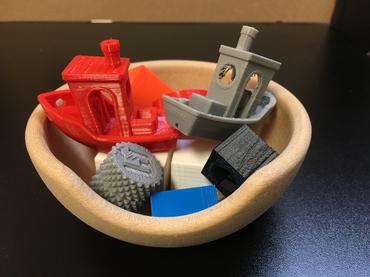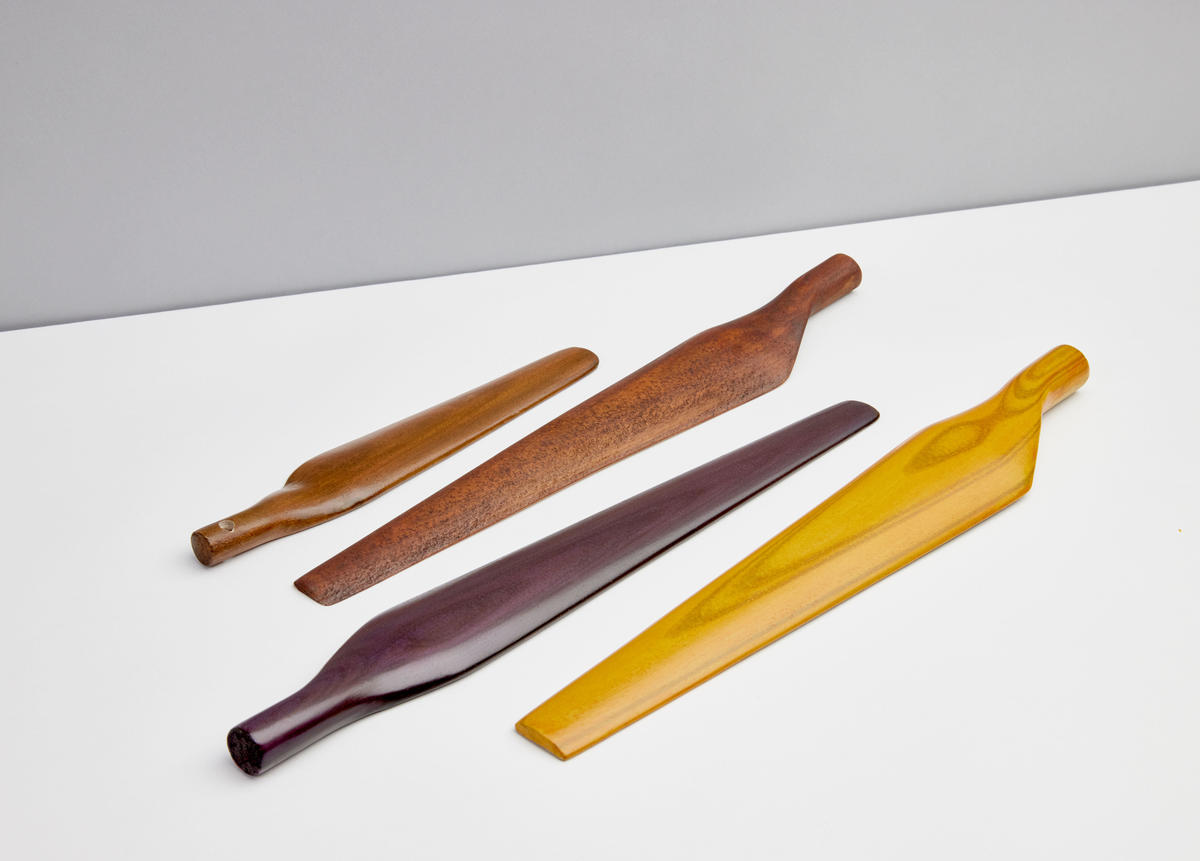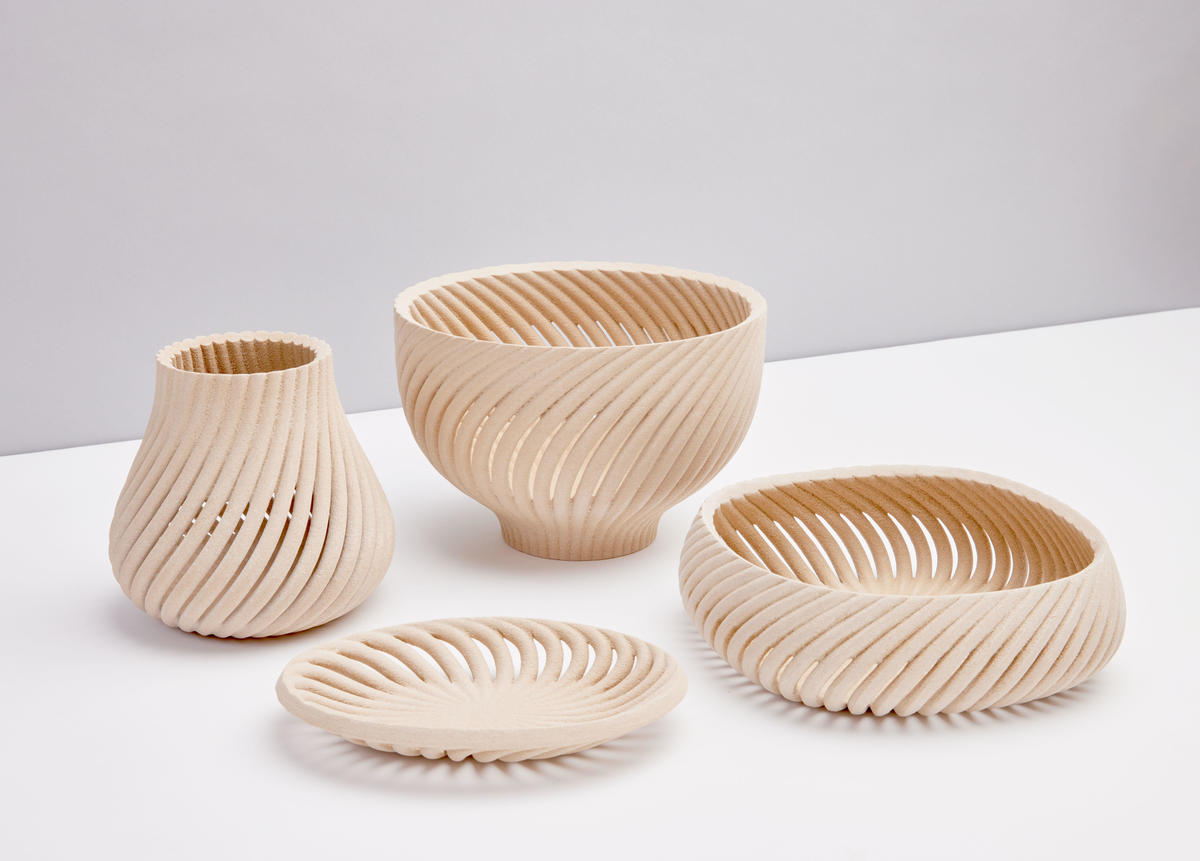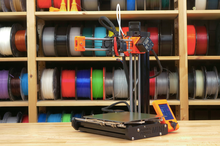3D printing “wood” has been with us for quite some time. Back in 2016, I showed how plastic filament infused with wood particles could be used to create objects that had a wood-like texture, could be sanded, and could take finish.

Sample wood filament bowl I finished with Danish oil
The biggest downside of wood filament was the lack of grain. The objects produced seemed a lot more like molded MDF (medium-density fiberboard) than crafted wood. Still, it was a nice filament alternative to have available for some projects.
Fast forward five years and a company with the name Desktop Metal is announcing its new additive manufacturing process for wood, called Forust. The company’s press release touts sustainability benefits, creativity benefits, the availability of wood grain, and more.
In fact, the company goes so far as to quote Arthur C. Clarke’s famous phrase about technology and magic, saying “Any technology that is sufficiently advanced is indistinguishable from magic.’ As a lover of wood and forests, I find Forust indistinguishable from magic.”
Any time a company’s own press release describes their process as “indistinguishable from magic,” it’s time to take a closer look.
Let’s first look at the process
Traditional woodworking is a subtractive process. You start with a tree, cut it into slabs, and then mill and finish those slabs. Or you take wood scraps, fuse them together into a particle board substance, and then cut apart the sheets, creating individual parts. In my shop, I have six separate power tools (circular saw, bandsaw, miter saw, table saw, track saw, jigsaw) all using slightly different methods for cutting wood into pieces.


Desktop Metal’s approach is to use a single pass binder jetting 3D printing technology, which is additive, not subtractive. In other words, instead of breaking down wood, it builds sawdust powder up into finished parts.
Binder jetting is pretty much how it sounds. A layer of powder is spread across the print surface. Then a layer of a binding agent (like a glue) is squirted onto that powder in a manner very similar to how inkjet printers squirt ink. This is done layer after layer until the 3D printed object is complete.
Usually, once the binder jetting process is complete, there’s some form of curing or post-processing, which helps the binder fuse with the powder material and remain solid over time.
Desktop Metal does not mention a curing or post processing method, but their powder is basically a refined form of sawdust. The company talks about using recycled wood waste and lignin (more on lignin in a minute) to create fully-realized wooden objects straight from their 3D printers.
The sustainable argument
Desktop Metal makes an interesting case for how this process might save trees and forests while simultaneously reducing wood waste. Wood waste is a serious concern. The website The Balance reports that 10 percent of all materials deposited in landfills is wood waste. And although this statistic is a decade old, The Balance reports that 70.6 million tons of urban wood waste was generated in 2010. Presumably, that can only have increased since then.
ZDNet Recommends
Best 3D printers under $500
Do you want to get started in the wonderful world of 3D printing, but don’t want to spend too much money? Well, you’re in luck. You can get started for as little as $100 (although things start to get better over about $200). We present a batch of really great options for beginners that will have you cranking out Baby Yoda replicas in no time.
Read More
Desktop Metal’s contention is that if they can upcycle that wood waste into new, 3D printed products, they can draw on the waste as a material source for wood, rather than cutting down more trees.
In theory, this is a grand idea. But the problem is that transforming wood scraps into wood powder requires energy, usually generated with fossil fuels. Even if the idea is to use wood waste as a fuel, burning the waste (which would also burn any glues, paints, and other possibly toxic coatings and adhesives) would release both carbon dioxide and toxins into the environment.
This is often a challenge with any sustainability endeavor. Creating a sustainable solution for one process usually requires the use of a non-sustainable process to drive or fuel it. In that, Desktop Metal’s approach is no different.
Another challenge is the processing of the lignin. Desktop Metal states, “The Forust process upcycles waste byproducts from wood manufacturing (cellulose dust) and the paper industry (lignin) and re-materializes functional wood parts through high-speed 3D printing including digital grain throughout the part.”
While the poetic use of “re-materializes” creates visions of Star Trek replicators, it’s the process of upcycling lignin that I want to look at for a moment.
Lignin is, according to Britannica, the second “most abundant organic material on Earth,” after cellulose. Unfortunately, not many industrial uses have been found for it, other than as a fuel and as a binding agent. The problem is, to use lignin as part of an upcycling process based on binder jet technology requires the lignin to be removed from the wood after the wood scraps have gone through a pulping process.
The company’s press release waxes poetic again, stating, “We are honoring the cellulose and lignin of the trees by rearticulating them into assets for present and future generations.”
Unfortunately, the process required to “honor” the cellulose and lignin, that is, to separate lignin from the pulp, requires the use of such nasty chemicals as sulfur dioxide, sodium sulfide, and sodium hydroxide.
Another approach to extracting lignin is “by breaking the lignin-carbohydrate complex through extensive ball milling or vibratory milling for 2-28 days. The lignin is extracted by dioxane/water with subsequent purifications in solvents.”
So, yes, wood waste could be converted into new 3D printed objects, and that would theoretically reduce the harvesting of trees. In fact, the company specifically claims, “Cost-Effective Carbon Footprint Reduction with On-Demand Manufacturing.”
But the cost, in terms of energy and toxic chemicals used to convert the waste into something that could be upcycled, could well exceed any benefits of the upcycling itself.
It’s a win-some, lose-some story. On the one hand, there might be a reduction in carbon footprint because objects are printed on-demand. But on the other hand, the overall cost in terms of energy usage (remember, 3D printers use energy) and carbon footprint to create the raw materials for on-demand production could well cancel out any of those benefits.
It’s proprietary! It’s magic! It’s proprietary magic!
In its announcement, the company offers two very compelling assertions. First, they state that they can embed realistic-looking wood grain throughout the part. Second, they state that design applications include architectural accents, luxury interior components, furniture pieces, and home goods products.
Let’s talk about that wood grain, first. One of the biggest limitations I saw back in 2016 when I experimented with wood filament was the lack of wood grain. The wood filament did, indeed, create a material that could be worked somewhat like wood. But it didn’t look like wood. It looked like molded sawdust.
Desktop Metals claims (and I’m using the word “claims” here on purpose) that “Forust produces a wooden part with a digital grain that flows throughout the entire part that can be sanded and refinished.”


But, how? Does the printing process deposit ink in multiple colors, or use multiple streams of wood products to reproduce that grain? Does the grain need to be built into the 3D model or is there a slicer that generates the grain look? Is the grain just a faux finish painted on top of the printed objects?
When I reached out to the company, I was given a surprisingly evasive answer by Andrew Jeffery, co-inventor of the Forust process: “While the specific process for applying the grain is proprietary, with the Forust process, we apply the grain not just on the surface of the part, but it’s fully throughout the entire part.”
So, yeah. Magic. Secret, proprietary, we’re-not-even-going-to-slightly-give-you-an-answer “magic.”
I want to give the company the benefit of the doubt, but I do think the fact that they led off with Clarke’s “indistinguishable from magic” quote and ended up with “proprietary” makes their claims worthy of some question.


Most of the images provided by the company look very similar to what I was able to produce back in 2016 with wood filament. Of the twelve images provided to me by the company, only four showed any grain at all (and two of those were simply different angles of the same objects).
Design applications and material limits
So that just leaves us with a final concern. The company says it can make chairs and tables with their Forust process. To be fair, I think we’ve all bought tables or shelves made out of MDF or particle board. Usually, there’s some veneer applied to make it look nice, but really, most of our modern knock-down furniture is some form of shavings or dust mixed with a binder agent, dressed up to look like wood.
But then we come to chairs. Think about how much weight a chair is asked to hold. Then think about those cheap MDF shelves we’ve all bought. How many times have you had shelves sag once you fill them with books? Now, imagine sitting on that material.
Sure, it’s possible to design something that adds support splines throughout the structure, but once you do that, you’re getting away from the idea of “re-materializing” fine furniture and more into the realm of creative experiment.
Can we see the Forust for the trees?
There is no doubt that 3D printing is a compelling process. Even as a jaded technologist, when I saw my first 3D print back in 2015, I felt like I was seeing the future. Whether objects are created from filament, resin, or powder, the one-off, on-demand production of layer-by-layer objects can be game changing.
Designs that are possible via 3D printing are often very difficult to impossible using subtractive manufacturing methods.
Had Desktop Metals simply highlighted their mechanism for converting wood dust into finished wood objects, I wouldn’t have been so skeptical. Had Desktop Metals given even the slightest indication of how they produce their wood grain effect, I wouldn’t have been so skeptical.
But the very fact that the company let their marketing folks get so out of control with wildly hyperbolic, over-the-top claims substantially reduces the credibility of what, at its core, might actually be a viable and interesting technology.
So, yes, using binder jet technology to create wood-like 3D prints is compelling. And being able (somehow) to embed grain in those prints is quite compelling. But we’ll have to wait and see to find out if this is the harbinger of a new production and technological revolution, or just another process we can use for certain niche products.
Stay tuned. We’ll be watching this one closely.
You can follow my day-to-day project updates on social media. Be sure to follow me on Twitter at @DavidGewirtz, on Facebook at Facebook.com/DavidGewirtz, on Instagram at Instagram.com/DavidGewirtz, and on YouTube at YouTube.com/DavidGewirtzTV.



